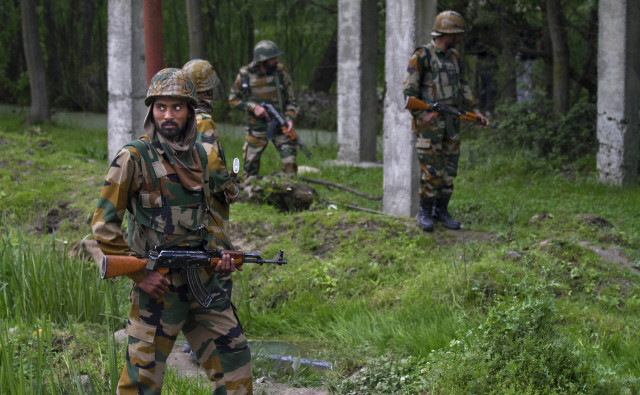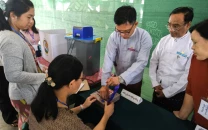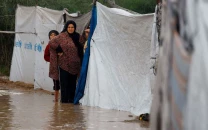Forest killings put India's 'fake encounters' in spotlight
Fake encounters increase as police simply want to avoid India's slow legal system

Fake encounters increase as police simply want to avoid India's slow legal system. PHOTO: AP
She only found out he was dead when his picture appeared on the local news describing him as a dangerous criminal who had been killed by police along with 19 others accused of smuggling sandalwood.
"He was only a painter," said the tearful 20-year-old, who had been married for just six months and who like many Tamils goes by only one name.
"Now I only want justice."
Indian police said last week they had acted in self defence when they fired on a group of alleged timber smugglers in the remote forests of Tirupati in the southeastern state of Andhra Pradesh, home to the rare trees that produce red sandalwood.
But activists and relatives have challenged that version of events, and on Wednesday a case was filed with a local court charging "unknown persons" in the force with murder and abduction.
It would not be the first deadly clash between police in the state and loggers of red sandalwood, which is smuggled to China and Japan where it is highly prized for its rich hue and purported medicinal value.
But the number of victims in this case was particularly high.
All 20 were from Tamil Nadu, where street protests erupted last week after news of the killings emerged.
Rights activists say the evidence points to a "fake encounter" -- a commonly used term in India for staged confrontations in which police or military forces execute unarmed suspects and later claim it as self-defence.
"If you do this for long enough, you can just tell when an encounter is staged," said Narayana Rao, an activist with the Civil Liberties Committee who helped lead a fact-finding mission at the spot where the incident purportedly took place.
"In a real encounter, the person runs at least a little once they've been shot, so bullet marks and blood stains are spread across the site.
"But here the blood is pooled only where the bodies were found, and the bullet wounds were concentrated in the victims' heads and torsos, suggesting they'd been brought here and shot."
Police in Andhra Pradesh declined to comment on those allegations.
When the activists took their findings to G. Srinivasalu, a district forest official in Tirupati, he said the victims were armed with axes, knives, and rudimentary firearms, and posed a threat to forest department personnel.
"Where were you when the forest officers were tragically murdered?" he said, referring to a December 2013 incident when two rangers were hacked to death by a group of smugglers.
On Monday, three witnesses told the National Human Rights Commission in New Delhi that police had arrested the victims at a forest checkpoint hours earlier, suggesting they were already in police custody when they died.
"They were going to find work in brick kilns," said Prabhakaran in Arasanattham village, where many of the victims -- including his father and Kanagarani's husband -- were from.
Prabhakaran told AFP the villagers initially believed the men had been arrested, after one survivor saw police hauling them off the bus on which they were travelling.
They only found out through the television that their loved ones had been killed.
In the past decade, police have seized nearly 15,000 tonnes of red sandalwood and arrested over 6,000 people with alleged links to red sandalwood smuggling.
They have mostly been migrant workers, while high-level culprits are seldom caught.
Tamil Nadu provides hundreds of migrant workers for the illegal but lucrative red sandalwood trade, although it remains unclear whether the latest victims were even involved in logging.
Fake encounters are especially common in areas where India's security forces are battling armed militants, such as separatists in the disputed region of Kashmir and Maoist insurgents in the restive central state of Chhattisgarh.
But activists and lawyers say they are increasingly seen in more peaceful areas where police simply want to avoid India's slow legal system.
"The idea is that you can't manage certain people within the ambit of the law," said Murali Karnam, an assistant professor of law at the Tata Institute of Social Sciences in Mumbai.
"You started with Maoists at first, but now the scope has been expanded to other sections like dacoits (bandits), minorities and smugglers."
Reliable statistics of fake encounters in India are hard to come by because authorities seldom recognise them.
The National Human Rights Commission -- a quasi-judicial body -- identified 555 instances between 2008 and 2013, but activists say the actual count is even higher.
Police and the military are rarely prosecuted although the Supreme Court ruled last September that police killings must be investigated by an independent agency or a unit not involved in the case.
V.S. Krishna of the Andhra Pradesh Human Rights Forum said in the forest killings, the police "barely even bothered to cover their tracks".
"They were that brazen," he said.
"Are these the actions befitting a democratic nation?"



















COMMENTS
Comments are moderated and generally will be posted if they are on-topic and not abusive.
For more information, please see our Comments FAQ